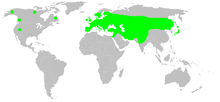Pumpkin spider
| Pumpkin spider | ||||||||||||
|---|---|---|---|---|---|---|---|---|---|---|---|---|

Pumpkin Spider ( Araniella cucurbitina ) |
||||||||||||
| Systematics | ||||||||||||
|
||||||||||||
| Scientific name | ||||||||||||
| Araniella cucurbitina | ||||||||||||
| ( Clerck , 1757) |

The pumpkin spider ( Araniella cucurbitina ) is a smaller orb web spider from the family of real orb web spiders (Araneidae). The name refers to the shiny, yellowish-green abdomen reminiscent of a pumpkin.
features
The females reach a size of about six millimeters, with the males it is about four millimeters. The abdomen ( opisthosoma ) is shiny yellowish-green in color and on both sides of the midline there are four to five pitted depressions that are dark in color. The prosoma (front body) and the legs are greenish-brown, the legs have many long, strong, dark bristles. The adult animals have a red spot on the end of the abdomen above the spinneret.
The newly hatched young animals are light-colored at the time of hatching, animals not yet sexually mature have a red or brownish color in autumn, so that they are well camouflaged when the leaves change color. The green color is then developed by adult animals in spring.
Similar species
- The extremely similar Araniella opisthographa (Kulczynski, 1905) can only be distinguished from A. cucurbitina genital morphologically .
Occurrence
The pumpkin spider is one of the most common native species of spider. They can be found in coniferous forests and forest edges, in bushes and hedges, but also in open land biotopes such as fallow land , ruderal meadows, fields, meadows, moors and swamps .
Way of life
The pumpkin spider knows no lurking hiding place on the web (retreat), because thanks to the greenish color of the body it can stay in the web without being noticed by the prey insects . The nets have a diameter of about ten centimeters and are laid diagonally to horizontally, mostly in the higher herbaceous layer or in trees and bushes up to a height of about three meters. They consist of 20 to 30 radii and have a catch spiral that consists of 10 to 15 turns. The nets are sometimes only designed as a semicircle.
In July, the females lay up to three egg cocoons near the net . These are whitish to yellowish in color and contain around 140 to 160 eggs . Sexually mature animals can be found from May to August. The adult males look for nets of female animals and wait there until the female is ready to mate.
The species overwinters in the juvenile stage on branches.
literature
- Heiko Bellmann : Spiders. Observe - determine. Naturbuch-Verlag, Augsburg 1992, ISBN 3-89440-064-1 .
- Dick Jones: The Cosmos Spider Guide. Over 350 Central European spiders and harvestmen. 4th edition. Franckh, Stuttgart 1990, ISBN 3-440-06141-8 .
- Frieder Sauer , Jörg Wunderlich : The most beautiful spiders in Europe. 5th edition. Fauna-Verlag Schliermann, Nottuln 1997, ISBN 3-923010-03-6 .



